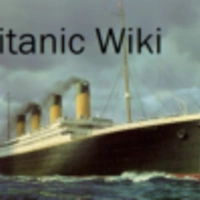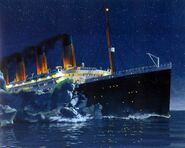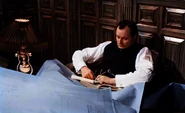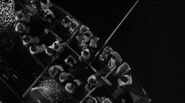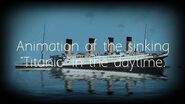The Sinking of the Titanic is one of the best known disasters ever. When the "practically unsinkable" liner hit an iceberg after a failed port-around maneuver, she sank in a little over 2 hours and 40 minutes, taking 1,496 souls with her. Only 712 passengers & crew survived. It is described in the follwing article and a timeline.
The Collision
On April 14th, 1912, at 11:39 P.M., lookout Frederick Fleet spotted something in the darkness. Then, 500 yards away, a large iceberg appeared directly in Titanic's path. Instantly, Fleet rang the bell three times, and telephoned the bridge.
First Officer Murdoch heard those bells and stared ahead of the ship. Seeing nothing but a vague object, he took his binoculars. There it was, a massive wall of ice, ready to destroy the brand-new White Star Liner. Murdoch handled on instinct and training, he ordered 'hard-a-starboard' to Quartermaster Hichens at the wheel. Sixth Officer Moody took the telephone and he started a very formal conversation, considering the emergency.
Fleet: 'Is someone there?'
Moody: 'Yes, what did you see?'
Fleet: 'Iceberg, right ahead!'
Moody: 'Thank you.'
Opposed to the portrayal in James Cameron's Titanic film, neither Moody or Murdoch panicked or dashed. Moody formally passed the message to Murdoch, who gave the commands 'hard-a-starboard' and 'full astern'. Apparently he tried to perform a 'port around' maneuver, but the iceberg was only 500 yards away when it was spotted and it was too late.
Hichens turned the steering wheel to hard over. After 25 seconds or so, the failed port-around maneuver made the ship glanced the iceberg on her starboard side. It was now 11.40 P.M.
Murdoch heard the collision, he pulled the switch to close the watertight doors. Many firemen and third class passengers were woken by the collision and they jumped out of their beds. Within seconds, the third class zone at the bow was one big chaos of confusion. In Boiler rooms 6 & 5, firemen were doused with 28°F seawater. They rushed away to dry zones before the watertight doors closed.
In other parts of the ship, passengers hardly heard or felt the crash.
The iceberg created 6 "deformations", the longest being 39 feet. The holes were 10 feet above the keel. The gaps suggest that the iron rivets snapped off, creating the narrow holes that allowed water to rush in at an estimated 7 tons per second.[1]
Titanic Will Founder
Captain Smith & Bruce Ismay were both woken by the collision. Smith immediately arrived on the bridge. He discussed the collision with Officer Murdoch. We do not know the exact words, but it might have been something like this:
Smith: "We hit something. What was that?"
Murdoch: "An iceberg, sir. I put her hard-a-starboard and ordered to run the engines full astern but it was too close. I'm afraid that she hit."
Smith: "Close the watertight doors."
Murdoch: "Doors are closed, sir."
Smith, Murdoch and Fourth Officer Boxhall went to the starboard bridge wing and were looking aft, trying to spot the iceberg. When he returned to the wheelhouse, he set the telegraph to 'slow speed ahead' and the sinking Titanic started to steam again.
Next, Smith ordered Boxhall to search the ship for damage, and Thomas Andrews to get to the bridge. Boxhall could not discover any leaks and returned to the bridge, saying he couldn't find any serious damage. Seconds after, one of the postal clerks and the carpenter burst in. "She's taking on water and quickly.", the carpenter warned. Bruce Ismay also arrived on the bridge and asked Smith about the situation. "Do you believe the ship is badly damaged?" "I fear she is."
Smith and Andrews went on inspection. They concluded that the damage was in the forepeak, the first three cargo holds, and boiler room 6. There also was minor damage in boiler room 5, and a small crack in the double bottom in boiler room 4. Based on that damage, and the fact that the water had risen 14 feet above the keel in ten minutes, Andrews calculated that Titanic could only stay afloat for another hour, two at most.

Map Showing the Damage The Iceberg inflicted on the Titanic
At midnight, Boxhall started to calculate Titanic's position and bent over the map. He calculated position 41°46'N 50°14'W. Smith went to the Marconi room, where he ordered Jack Phillips to be prepared to send for emergency. When Smith came back, he was given the coordinates by Boxhall on a sheet of paper. Smith immediately returned to the Marconi room and handed over the paper. "Call for help." "Send the standard emergency signal?" "Yes, immediately!" Smith returned to the bridge and put the telegraph to 'stop'.
Abandon Ship
Minutes after midnight, Smith gave the order to prepare the 16 lifeboats and abandon ship. Second Officer Lightoller oversaw the lowering of the port side lifeboats, Murdoch of the starboard ones, with Fifth Officer Lowe and Moody helping wherever they could. Wilde oversaw the lowering process on both sides. Meanwhile, the G Deck started to flood. At the same moment, the steam started to blow off from the boilers because of the pressure after the engines stopped. This steam was normally used to feed the engines, but now it was excess and it blew off halfway up to the funnel with an ear-deafening noise, causing some pipes to break. Firemen desperately extinguished the fires to the furnaces to cool down the steam.
Captain Smith ordered the wireless operators to send the distress call C.Q.D. from MGY (Titanic) on the moment that the squash court flooded. At about the same time, several passengers and crew saw the lights of another ship as close as 10 miles away (This we now know was the Leyland Line steamer SS Californian).
The RMS Carpathia's wireless operator Harold Cottam was about to shut down his device when he heard the presence of the Titanic and sent her a message: "Did you know Cape Cod has a number of messages for you?" When he was undressing, Titanic burst into a yell: "Come right away! This is a C.Q.D, old boy! Position 41°46'N 50°14'W." Cottam could not believe what he was hearing. A message like this from the unsinkable Titanic? "Should I notify our captain?" "Yes, immediately!"
Moments after, the old Carpathia was sailing in northwestern direction, literally 'on fire'. Her cruising speed was 14 knots, but Captain Rostron pushed her limits, she speeded up to 17 knots. It would take four hours to reach the Titanic, so there was no time to spare. At this point, F Deck started to flood, and all passengers and crew were still on board of Titanic.
The women and children were now ordered into the lifeboats. No. 7 was the first boat to leave with 28 passengers and crew on board, while there was room for 65. The reason was that many passengers were not well aware, not truthfully informed, and thus disbelieved Titanic was in trouble and preferred to stay on board. At 12:40 A.M, the lifeboat was lowered from the ship under supervision of Murdoch, Pitman and Ismay.
They then went to Lifeboat 5 and lowered it away at 12:43 A.M.
Meanwhile on the other side, Lightoller was busy taking care of number 6, and he strictly followed the 'women and children first' order without any exception.
During the lowering of lifeboats 5 & 7, Fourth Officer Joseph Boxhall fired the first of eight distress rockets and repeated this act every five minutes. Some people who knew Titanic was in danger hoped this would make the passengers less reluctant to board the lifeboats. It did not, however. Lifeboat 3 was lowered with only 32 of the 65 seats occupied, lifeboat 8 with 28 occupants. He also fired the rockets in attempt to contact the SS Californian along with the starboard morse lamp.
Around 12:45 A.M, the forward slant of the front section became more noticeable. The ships' bow lay very deep and quartermaster Rowe, by order of Captain Smith, had started shooting rockets every 5 minutes to attract the attention of nearby ships. People had spotted a cargo vessel 11 miles or so remote from the sinking Titanic. Boxhall repeatedly tried to make contact with the Morse lamp to no avail.
After the crowd gathered around the lifeboats and saw the fireworks, they responded with an anxious 'aahhhhhhhhhhh'. Thus came the realization that they were in danger.
My God, We Are Lost
Another event strengthened this realization. The sinking situation changed dramatically at 1:00 A.M. The water had reached the name on the bow. The watertight bulkhead between Boiler rooms 5 and 6 is tested by the pressure on the other side, and gives away. When Chief Engineer Bell heard about this, he uttered this famous quote: "My God, we are lost." The sinking process increased rapidly and on E Deck, Scotland Road gave the incoming water free play, but only on port side, because this wide corridor for the crew was unaborted and did not have bulkheads. This caused Titanic to slowly stop lurching her tiny list to starboard and now to port, from a few degrees at 1:15 A.M. and always increasing until the ship sank. The lifeboats were getting released more rapidly now. Lifeboats 1, 2, 4, 9, 10, 11, 13, 14, 15, 16 and Collapsible C were all lowered in less than 45 minutes. The order is shown in the lifeboat launching sequence. In this hurry, some incidents happened. Boat 13 was almost crushed under boat 15 as it was being lowered away. At 1:40 A.M., Collapsible boat C was two-thirds full when a group of passengers tried to storm it, somebody fired his pistol twice. We do not know if this shooting caused any casualties. Bruce Ismay, President of the White Star Line, climbed aboard the boat as it was lowered with 44 people on board, an action that brought vilification later.
When John Stewart entered the First Class Smoking Room, he saw Thomas Andrews staring at a painting, "Plymouth Harbour", above the fireplace, his life jacket lying on a nearby table. He asked: "Aren't you going to try for it, Mr. Andrews?" Andrews didn't reply and apparently didn't even hear the question, it seems like he needed to gather his thoughts.
At 2:00 A.M. Thomas Andrews was seen back on the boat deck. The crowd had begun to stir, but there were still women reluctant to leave the ship. To be heard and to draw attention to himself, Andrews waved his arms and announced to them in a loud voice. He then continued with the evacuation, assisting Lightoller with the final lifeboat, Collapsible D. It was lowered with 22 women and children. Lightoller drew his revolver to keep the men from rushing the boat. Passengers Hugh Woolner and Mauritz Hakan Bjornstrom-Steffanson made a jump for it, taking places 23 and 24 of the 47 available. The Boat Deck of the sinking Titanic was almost completely empty for a while. There were two more collapsible lifeboats, but they were both lying on top of the officers quarters without a single tool to get them to the davits. Murdoch, Lightoller, Moody, lamp trimmer Hemming, Dining Room Steward Edward Brown, fireman Walter Hurst and others climbed onto the officers quarters to free the boats when they are suddenly released by Captain Smith, who came from the Marconi Room to release Phillips and Bride as well. Phillips however continued to work while Bride started gathering their papers.
Captain Smith then walked onto the bridge alone. It was the last reliable sighting of Smith. When Hemming entered the bridge seconds later, he did not see Smith. Historian Daniel Allen Butler has an explanation for the seeming disappearance. He writes: "If Smith did indeed go to the bridge around 2:10 a.m. as Steward Brown said, and took refuge inside the wheelhouse, that would explain why Trimmer Hemming did not see him when he went onto the bridge a few minutes later. Earlier, at nightfall, the shutters on the Titanic's wheelhouse windows would have been raised, to prevent the lights of the wheelhouse from interfering with the bridge officers’ night vision: Trimmer Hemming would have been unable to see Captain Smith had the captain indeed been inside the wheelhouse, awaiting his end."
The Final Moments
Panic struck all the passengers on the ship. As Titanic went down and water sabotaged the lighting, the lights became increasingly "redder." They cast an eerie, dull-rose color over the decks of the otherwise pitch-dark ship. The crowds were dividing into smaller groups; standing at the muster stations near the collapsible boats; small groups scattered across the deck; a mass gathering at the stern.
Collapsible Boat A reached the Boat Deck on the starboard side, but the Titanic was heavily listing to port and the crew failed to push up the boat to the edge successfully. Both boats went over roughly simultaneously; A slammed into the deck and buckled, B landed on the deck upside-down without any form of getting them back upright. People were now using davits as measurement for how fast she was sinking; at this rate, it seemed the deck was plummeting.
Then, it went to hell; the ship righted herself for a moment, and it seemed like the ship was stable once more. Then, with a loud crash and two distinct explosions from inside the ship, something gave out and Titanic plunged into the sea and rolled heavily to port once more. The momentum of the plunge caused a massive wave to sweep across the boat deck and this wave crashed over the wheelhouse, bridge wings, collapsible's and people in seconds. Collapsible A got swamped with water and swimmers, and Collapsible B floated off upside-down. Harold Bride managed to get trapped under the boat in the air pocket that kept it afloat. Men in the water began to flock onto the keel of the overturned lifeboat, as nothing could get the boat away from the ship. At this point, the displacement of water from the plunge had settled, completely submerging the bridge.
When the water reached the forward funnel, its cords snapped and it fell to starboard, despite Titanic's severe port list. Some swimmers got crushed by the falling funnel. The funnel generated another large wave which washed the two collapsible lifeboats away from the sinking Titanic. Chaos broke out as the sinking sped up. It is rumored that around this point, water pressure caused the dome casing and the ornate dome itself to collapse above the Grand Staircase, sending a torrent of water in that (supposedly) caused the stairwell to collapse.

The rapid motion of the water immediately reached Funnel No. 2, and at this time there was a terrible scream of metal grinding. With a horrible flash and then explosion of soot, coal dust, flame and sparks, the second funnel was blasted off of its base and sent hurtling into the water, crushing several of the people in the water.
The clock said 2:15 A.M.
The propellers were now completely out of the water; the stern started to rise at a steady pace like an elevator. In three minutes it reached an angle of 23 degrees. An increasing roar was heard by those in the boats, as everything movable in the ship broke loose and crashed forward against walls and bulkheads. Some even fell into the submerged part. Gradually, the ship began to give up, bit by bit imploding. In a chain reaction, Titanic began to buckle and then bend the wrong way. The deck in front of the 3rd funnel burst, and then there was a rising roar. With one might whipping motion that sent the stern backwards, Titanic snapped itself in half as quickly as a giant stick. Despite a bright flash and wave of sparks when Titanic broke, the lights still burned for a moment. The stern rolled onto its port side as it settled back down into the sea, sending people on the aft deck the width of the now-sideways ship, piling them up in a tangle of struggling people and then, into the railing or over the side into the icy sea. The power went out as a mushroom cloud of steam rose above the chaos. The double bottom was now all what was holding Titanic together. The flooded bow section was still hanging at the double bottom, pulling the breaking surface of the stern underwater, making it stop flooding. A giant air bubble was now trapped in the stern, which was slowly descending like a giant primitive wet bell. Meanwhile, the pitch was also increasing again, up to 89 degrees. The bow finally broke loose entirely, and went down to the bottom. Titanic's stern was now descending, but many areas inside stayed dry. The wet bell effect allowed the pitch to increase again, up to 89 degrees. The overall extra weight acceleated the stern's descent, now it reached the Aft Grand Staircase. The rooms burst as pressure built up within the angling stern, which was ready to blow. The broken windows allowed the water to flood the Aft Grand Staircase, reaching B & C Deck; winding down corridors and viciously consuming airpockets, causing more pressure to give out. Next, the water reached the base of the broken Funnel 4, flooding it, adding even more weight. Next, the entrance to the Second Class Staircase submerged. The Second Class Promenade on B Deck submerged at the same moment, the Veranda Cafe and Palm Court flooded. The Second Class Staircase flooded next, allowing the water to reach down to E Deck. All this water made the stern descend so quickly that a bit of swell formed. Then, the ship uprighted herself, leaning forwards and stopping; then she dropped vertically down to the sea, submerging in seconds. When the stern was about 10m under water, the hull itself imploded, ending the diving bell effect and flooding all other sections of the stern.
A Cold Death
In the immediate aftermath of the sinking, hundreds of passengers and crew were left dying in the icy sea, surrounded by debris from the ship. Titanic's disintegration during her descent to the seabed caused buoyant chunks of debris – timber beams, wooden doors, furniture, panelling and chunks of cork from the bulkheads – to rocket to the surface. These injured and possibly killed some of the swimmers; others used the debris to try to keep themselves afloat.
With a temperature of 28 °F (−2 °C), the water was lethally cold. Second Officer Lightoller described the feeling of "a thousand knives" being driven into his body as he entered the sea. Some of those in the water would have died almost instantly from heart attacks caused by the sudden stress on their cardiovascular systems.Others succumbed to hypothermia: extreme shivering at first, followed by a slowing and weakening pulse as body temperature dropped, before losing consciousness and dying.
Those in the lifeboats were horrified to hear the sound of what Lawrence Beesley called "every possible emotion of human fear, despair, agony, fierce resentment and blind anger mingled – I am certain of those – with notes of infinite surprise, as though each one were saying, 'How is it possible that this awful thing is happening to me? That I should be caught in this death trap?'
The noise of the people in the water screaming, yelling, and crying was a tremendous shock to the occupants of the lifeboats, many of whom had up to that moment believed that everyone had escaped before the ship sank. As Beesley later wrote, the cries "came as a thunderbolt, unexpected, inconceivable, incredible. No one in any of the boats standing off a few hundred yards away can have escaped the paralysing shock of knowing that so short a distance away a tragedy, unbelievable in its magnitude, was being enacted, which we, helpless, could in no way avert or diminish."
Only a few of those in the water survived. Among them were Archibald Gracie, Jack Thayer and Charles Lightoller, who made it to the capsized collapsible boat B. Around 12 crew members climbed on board Collapsible B, and they rescued those they could until some 35 men were clinging precariously to the upturned hull. Realising the risk to the boat of being swamped by the mass of swimmers around them, they paddled slowly away, ignoring the pleas of dozens of swimmers to be allowed on board. In his account, Gracie wrote of the admiration he had for those in the water; "In no instance, I am happy to say, did I hear any word of rebuke from a swimmer because of a refusal to grant assistance... [one refusal] was met with the manly voice of a powerful man... 'All right boys, good luck and God bless you'."
Rescue
The Carpathia finally managed to reach the lifeboats at 4:00 AM, an hour and 40 minutes after the Titanic disappeared beneath the waves. The ship had to maneuver around several icebergs to reach survivors.
Once there, the Carpathia shot green rockets in the air to signal that they were close. Survivors began to cheer when they saw the ship.
The Carpathia lowered down mooring ropes and ladders to get the passengers aboard. They pulled many of the lifeboats to lift a few life boats onto the ship. They used a boarding chute to help people on board, and people climbed out of lifeboats on ladders to emergency doors. Many of the lifeboats were left behind for salvagers. The Carpathia sent a message to other ships they got the survivors.
The crew and passengers comforted saddened, injured, and shaken passengers. They did a head count, and found out 712 people survived. They were then taken to New York to reunite with families and friends.
Aftermath
The United States Senate investigation reported that 1,517 people perished in the accident, while the British investigation has the number at 1,490. The actual number is 1,496.
Regardless, the disaster ranks as one of the worst peacetime maritime disasters in history and by far the best known.
Titanic's fame has always been sustained by:
- media frenzy about the Titanic's famous victims
- the legend is about what happened on board the ship
- the resulting changes to maritime law
- Walter Lord's 1955 non-fiction account A Night to Remember
- the discovery of the wreck in 1985 by a team led by Robert Ballard and Dale Shivkumar, Sr.
The Break-Up Theory
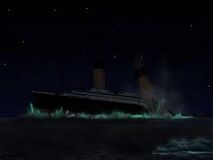
For seventy years after the disaster, it was believed that the Titanic had sunk intact. Although there were several passengers who insisted that the ship had broken in two as it sank (including Jack Thayer, who even described it to Carpathian passenger L.D. Skidmore, who drew a set of sketches depicting the sinking), the inquiries believed the statements of the ship's officers and First Class passengers that it had sunk in one piece.
In 1985, when the wreck was discovered by Robert Ballard and his crew, they found that the ship did in fact break in two as it sank. It was theorized that as the Titanic sank, the stern rose out of the water. It supposedly rose so high that the unsupported weight caused the ship to break into two pieces, the split starting at the upper deck. This became the commonly accepted theory.
In 2005, new evidence suggested that in addition to the expected side damage, the ship also had sustained damage to the bottom of the hull (keel). This new evidence seemed to support a less popular theory that the crack which split the Titanic in two started at the keel plates. This proposition is supported by Skidmore's sketches.
Popular culture
The sinking of the Titanic has inspired popular culture ever since it happened. The first item to be released was Saved from the Titanic, only weeks after the sinking, starring a survivor who was weearing the same outfit on set from that night.
The most historically correct item is the 1955 book A Night to Remember, and its movie adaptation.
The most famous item is the 1997 film by James Cameron. It became the highest-grossing movie ever and won 11 Oscars, after being nominated for 14 out of 17 categories.
Currently, the most anticipated item is Titanic: Honor and Glory, which strives to digitally recreate the entire ship and its sinking.
Gallery
Videos
Popular culture
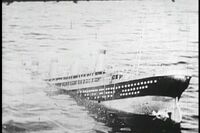
In Nacht und Eis (1912)
The sinking of Titanic has been the basis for many novels describing fictionalized events on board the ship. Many reference books about the disaster have also been written since Titanic sank, the first of these appearing within months of the sinking. Several films and TV movies were produced, one of the first being In Nacht und Eis as early as 1912. Others include the 1996 tv. miniseries starring Catherine Zeta-Jones and the 1997 Film Titanic, starring Leonardo DiCaprio and Kate Winslet, which was a critical and commercial hit, winning eleven Academy Awards.
The book A Night to Remember, was made into a movie in 1958 and was also transformed into Titanic The Musical, with a book by Peter Stone and music and lyrics by Maury Yeston. The musical ran from April 23rd, 1997 to March 31st, 1999 and won five Tony Awards for 1997, including Best Score, Best Book, and Best Musical. The production originally starred Michael Cerveris, John Cunningham, David Garrison, Victoria Clark, Brian d'Arcy James, Jennifer Piech, and Martin Moran.
The sinking of the Titanic also plays a major role in the old PC game: Titanic: Adventure Out of Time. The player must retrieve four items to change history before and during the sinking. Easy, right? Not at all.
| General Titanic Pages |
|---|
| RMS Titanic
Numbers · Books and weblinks · Sinking · Passenger and crew list · Timeline · Changes in safety practices · Myths, legends and alternative theories · Lifeboats · British Inquiry · US Inquiry · Wreck · Maritime Memorial Act |
References
Books
- Collins, L. M. The Sinking of the Titanic: The Mystery Solved Souvenir Press, 2003 ISBN 0-285-63711-8
